Welcome to the 15th installment of my article series, Track Breakdowns.
In this series, I look at the theory and arrangement behind popular songs, ultimately showing you what makes each song work.
In this breakdown, we’ll look at Disclosure’s track Omen featuring Sam Smith.
Omen is a perfect example of Disclosure’s pop-friendly writing style. It’s a club-focused track that fits just as well on a Top-40 radio station.
Let’s dive right into the breakdown.
Get 25 high-quality MIDI chord progression files for free 🎹
Our Track Breakdown MIDI Vault is packed with chord progression MIDI files from songs like Mura Masa’s ‘Lovesick’, Flume’s ‘Say It’ & more! 👇
The Sauce
Omen is in the key of Eb major.
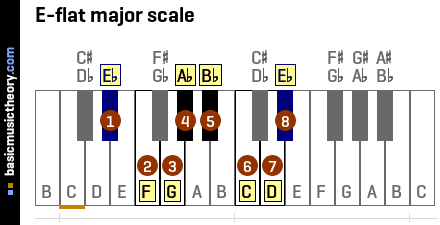
There are three different chord progressions used in this song.
Let’s start with chord progression used in the chorus.
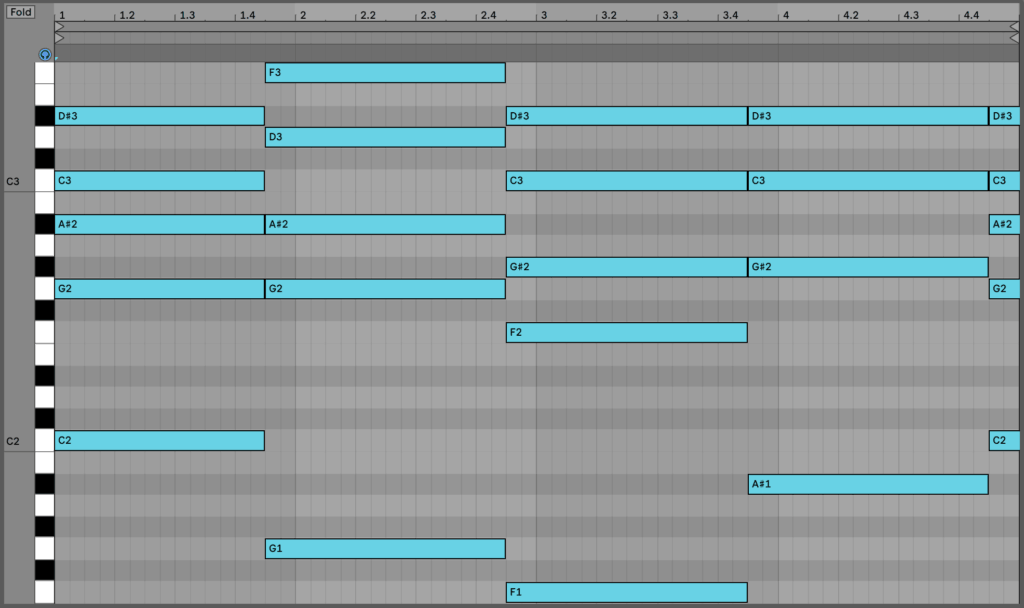
What’s going on here?
This progression is: Cm7 – Gm7 – Fm7 – Ab/Bb
- Cm7: C – Eb – G – Bb
- Gm7: G – Bb – D – F
- Fm7: F – Ab – C – Eb
- Ab/Bb: Ab – C – Eb (with Bb in the bass)
Numerically, this is: i – v – iv – VI/VII
Let’s dive into this chord progression a bit deeper.
How Disclosure Writes a Chord Progression
How would you describe the emotional tone of this track?
….
To me, this track is smooth, jazzy, and a little bit sexy.
It has the vibe of a traditional R&B song paired with a modern house production.
Why should we care about this?
Because it’s important to relate music theory concepts to the emotion that they convey.
Understanding how to build a particular chord is important.
What’s more important is knowing when to use it.
It’s not enough to know that Disclosure uses certain types of chords. You need to know why they use them as well.
Now that we understand how this chord progression makes us feel, let’s talk about how they achieved this.

Again, this progression is: Cm7 – Gm7 – Fm7 – Ab/Bb
The first three chords are all minor seventh chords.
As I discussed in my different chord types article, minor seventh chords sound moody and emotional. They’re common in R&B and have a rich, colorful tone.
A chord progression that uses three of them will most certainly come off sounding moody and emotional.
In fact, this progression uses all three minor seventh chords found in the key of C minor (quick tip: every major/minor key has 3 minor seventh chords).
What about the last chord?
The last chord in this sequence is Ab/Bb.
This is a slash chord, which is a chord where a note other than the root is played in the bass.
(If you’re new to slash chords, check out my track breakdown of Kaytranda’s track Got It Good)
Specifically, it’s an Ab major chord with Bb in the bass.
Why did they use Bb in the bass?
It could be for a few reasons, including:
- To add color to that chord
- To lead back into the one chord (since Bb is the seventh and the next chord is the one chord, i.e. 7 ->1 )
What do I mean by “add color”?
Rather than give the listener a clean Ab major chord, creating a slash chord adds a bit of tension.
The analogy I always use is instead of giving the listener everything on a silver platter, you make them work for it.
Adding extra tension gives the listener something to listen for.
To further this point, let’s listen to this chord progression without that slash chord.
Take a listen to the example below, and notice how the fourth chord sounds flat compared to the rest.
Cm7 – Gm7 – Fm7 – Ab
Listen back to the original and notice how the fourth chord adds a bit of color to the progression and pushed it back towards the one (i.e. the start).
Cm7 – Gm7 – Fm7 – Ab/Bb
Much better.
To recap, what makes this chord progression work?
Simply put, it’s the use of minor seventh chords and a colorful slash chord.
For example, let’s listen this progression stripped of it’s sevenths and stripped of it’s slash chord.
Cm – Gm – Fm – Ab
This progression is nothing to write home about. By adding a few sevenths and adding a slash chord, Disclosure was able to take this dull progression and give it life and character.
Cm7 – Gm7 – Fm7 – Ab/Bb
In other words, a chord progression doesn’t need to be complex to be interesting.
You’re likely already familiar with these two concepts. If not, research them further to add additional tools to your songwriting arsenal.
The Disclosure Arrangement
In my breakdown of Ekali and Medasin’s track Forever, I pointed out that they used 9 different chord progressions in that song.
This may seem like a lot, but it’s what was needed to make that song work.
While their initial chord progression was good, it wasn’t strong enough to carry the weight of the full track.
A song that heavily contrasts this is Daft Punk’s Get Lucky.
The chord progression in that song is so catchy that it plays throughout the entire track.
The main idea in Get Lucky is so strong that they never have to leave it.
How does this tie in with this breakdown?
Disclosure often follows in the path of Get Lucky, creating one chord progression that is used throughout the entire track.
I like to call this the Disclosure Arrangement: create a solid core idea that plays throughout nearly the entire track.
If your initial chord progression is really great, you don’t need to cycle through different progressions to make that arrangement work.
If your core idea is solid, the listener will want to hear that idea again and again.
A chord progression with four diatonic triads probably isn’t going to do the trick. You’ll need to reach for more exciting chords to make that initial progression shine.
Disclosure typically uses colorful extensions and borrowed chords to make their progressions stand out.
Their tracks Latch, Willing & Able, and White Noise all incorporate these techniques.
Omen follows this pattern to a degree, but strays from it during the pre-chorus.
Let’s dive into this pre-chorus, looking at how Disclosure developed a new chord progression that worked well in context.
How Disclosure Writes A Pre-Chorus
The number one role of a pre-chorus is to get the listener out of the verse and into the chorus.
It’s a section where tension is not only common, but encouraged.
Pre-choruses are a great way to build up tension that is ultimately released in this chorus.
From a theory perspective, you can embrace the power of tenser chords, such as diminished and augmented triads.
Let’s look at how Disclosure was able to create this tension in their song Omen.
Below is a transcription of the chord progression used in the pre-chorus.
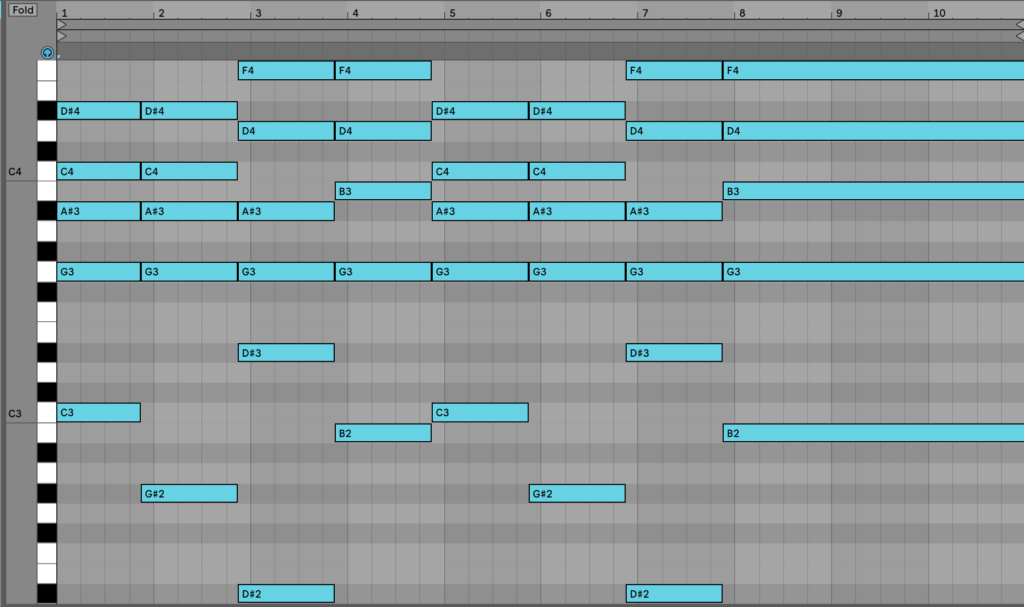
This progression is: Cm7 – Abmaj9 – Ebmaj9 – G7/B
- Cm7: C – Eb – G – Bb
- Abmaj9: Ab – C – Eb – G – Bb
- Ebmaj9: Eb – G – Bb – D – F
- G7/B: G – B – D – F (with B in the bass)
The first chord is the same as in the chorus progression.
The second and third chords are major 9th chords. Both are diatonic, meaning they only use notes within the C minor scale.
These chords add a more uplifting tone to the progression, which contrasts the more minor centric chorus progression.
By starting on the same chord, Disclosure makes the transition between the pre-chorus and chorus feel smooth.
By varying the last three chords, Disclosure creates a purposeful distinction between those sections.
A key element of this separation is the final chord used in the chorus, which is G7/B.
If you look back at the C minor scale, you’ll notice there is no B, only a Bb.

This means that G7/B must be a borrowed chord.
In particular, it is a secondary dominant.
If you’re a fan of this series, you’re likely familiar with them as several of the songs I’ve broken down use them.
(Check out my breakdown of Flume’s track Say It if you’re not sure what secondary dominant chords are.)
Let’s talk about why this particular chord works.
G7/B is the last chord in this progression, meaning the chord that follows it is Cm7.

A secondary dominant chord is the dominant seventh chord that is a perfect fifth above the chord it precedes.
G is a perfect fifth above C, so this checks out.
Although it isn’t just G7, it’s G7/B.
Why did Disclosure decide to go with a slash chord?
They likely did so for the same reasons they used a slash chord in the chorus:
- To add color to that chord
- To lead back into the one chord
The B->C minor second motion in the bass is extremely powerful. You normally don’t find this movement in C minor because the seventh is Bb, not B.
However, there is a natural B in C harmonic minor.
The harmonic minor scale is like the minor scale, but it unlocks the dominant resolution of the major scale.
Click here if you’d like to learn more about it.
Otherwise, listen back to this chord progression and notice how it creates tension and pulls strongly towards the next chord.
Cm7 – Abmaj9 – Ebmaj9 – G7/B
For comparison, let’s listen to this chord progression if that fourth chord was diatonic (i.e. not borrowed) instead.
Cm7 – Abmaj9 – Ebmaj9 – Gm7
This progression works fine, but it doesn’t have the tension and pull of the original.
What can you take away from this?
First, a pre-chorus is a great way to create tension that builds into the chorus. A good way to create this tension is to introduce a new chord progression.
Second, secondary dominants have shown up again and again in this series for good reason.
They are an extremely effective way to add exciting tension and resolution to a chord progression.
How Disclosure Crafts a Baseline
I’d be hard pressed to talk about Disclosure’s songwriting without talking about their basslines.
Funky, groove-driven baselines are a key element of nearly every Disclosure track.
Take a listen to the bass in the chorus of Omen (starts at 0:59).
Below is a transcription of this baseline. I’ve done a quick remake to give it more context.

There are two core elements that make this baseline work: melodic contour and swing.
Melodic Contour
One of the best ways to give your baseline more character is to give it a distinct melodic pattern.
Most producers simply outline the root notes of their chords and call it a day.
A more creative approach is to use the root notes as a starting point, building off of them.
This is what Disclosure did during the chorus of Omen.
Their baseline focuses around the root notes, but plays off of them to add interest and variation.
It includes several octave jumps, where they play the same bass note an octave higher.
This was a simple but effective way to add movement to their baseline melody.

Rather than looping this 4 bar idea, they added variation the second time around.
Below is a transcription of Bars 5-8 of this bassline.
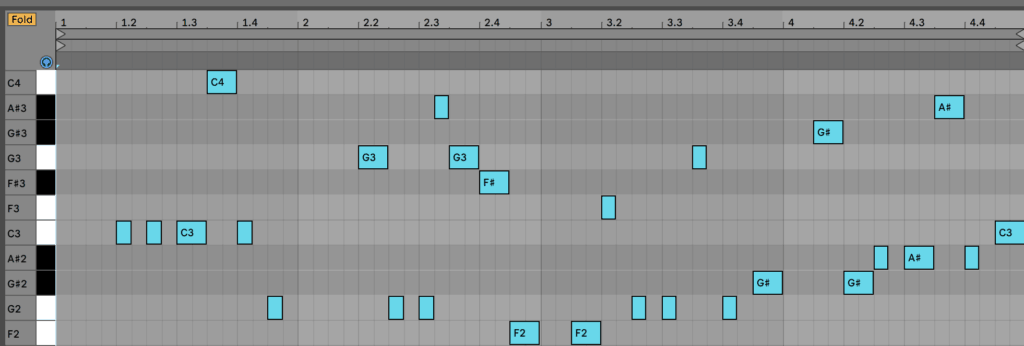
This bass melody introduces more melodic variation where it strays away from the root note, playing other notes in the scale.
All together, this creates a catchy and exciting 8 bar bassline melody.
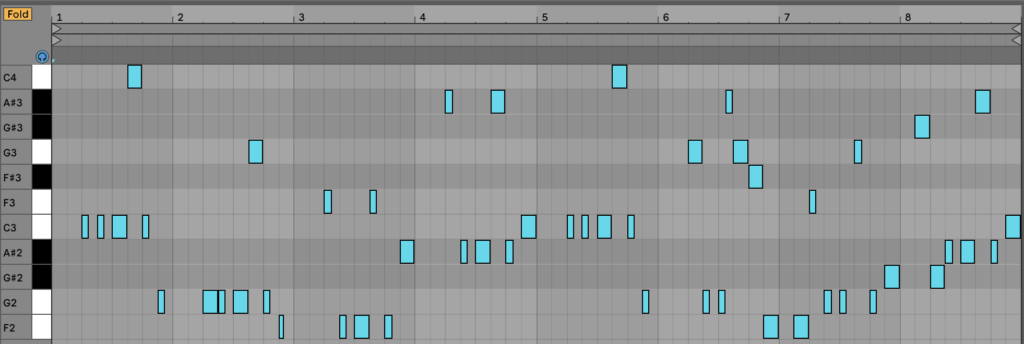
Swing
The second element that makes this baseline work is it’s swing.
Most producers are familiar with the concept of swing, but their music sure doesn’t show it.
Their demos often sound stiff and inhuman, lacking the character and groove of professional tracks.
While their drums and percussion may have a good groove, their chords and melodies are locked to the grid.
If you aren’t already, be sure to focus on the rhythm and timing of your core melodic elements.
In Omen, there were two primary ways they added groove to their chorus baseline.
The first was with the envelope of the bass sound.
In common Disclosure fashion, the envelope on their bass sound has a medium attack that slowly filters open.
This helps to push the “attack” of the sound off the grid, adding an element of swing.
Below is an example of this bassline with a fast attack and a medium attack. Notice how the former example is much stiffer then the latter.
Fast attack:
Medium attack:
This isn’t a steadfast rule, but it’s important to think about how your synth’s filter envelope can affect that sound’s groove.
The second technique they used was to pull the bass notes off of the grid.
This helps add human swing and variation.
To achieve this affect, you can directly move MIDI notes off the grid or you can use your DAW’s native track/sample delay.
Let’s listen to an example of this baseline with and without a 30ms track delay.
Without track delay:
With track delay:
Notice how the first example is stiff and robotic while the second example has swing and groove.
It’s a simple adjustment, but it’s enough to make (or break) a track.
What can you take away from this?
Treat your bassline as both a melodic and a rhythmic element.
Doing so will add an extra element of depth and groove to your music.
Want free access to the Track Breakdown MIDI Vault? You can download the MIDI from all of our Track Breakdowns, as well as 25 hi-quality MIDI chord progressions you can use in your own productions.
Get 25 high-quality MIDI chord progression files for free 🎹
Our Track Breakdown MIDI Vault is packed with chord progression MIDI files from songs like Mura Masa’s ‘Lovesick’, Flume’s ‘Say It’ & more! 👇
Conclusion
I hope you were able to take away some useful tips and techniques from this article.
I tried to pull out as much valuable information as I could from this song, helping you to better understand what makes a great song, great.
Lastly, if there are any songs you’d like covered, please let me know!
Want to read more breakdowns? Click here to visit the Track Breakdown Glossary.

